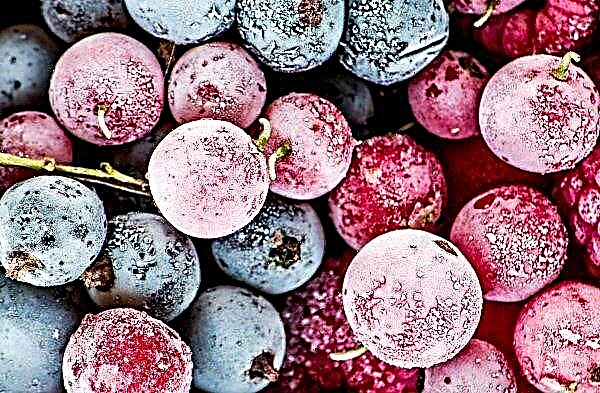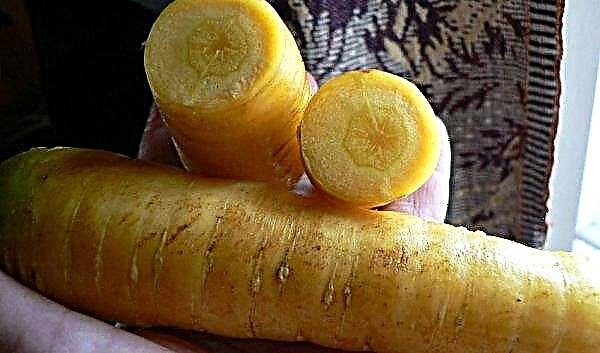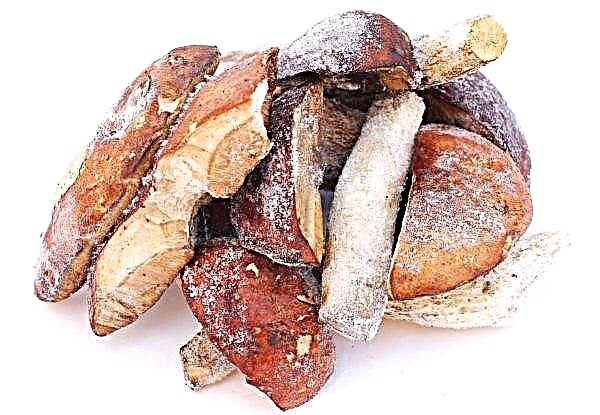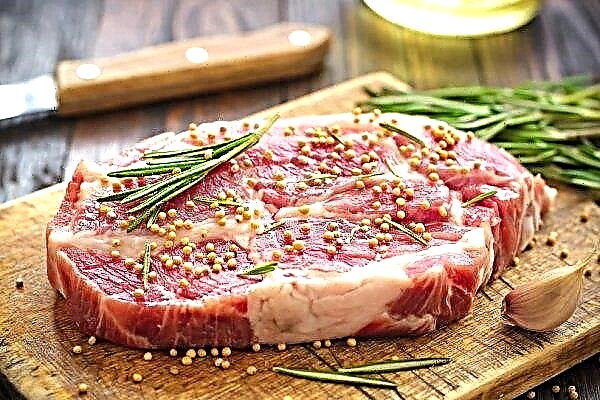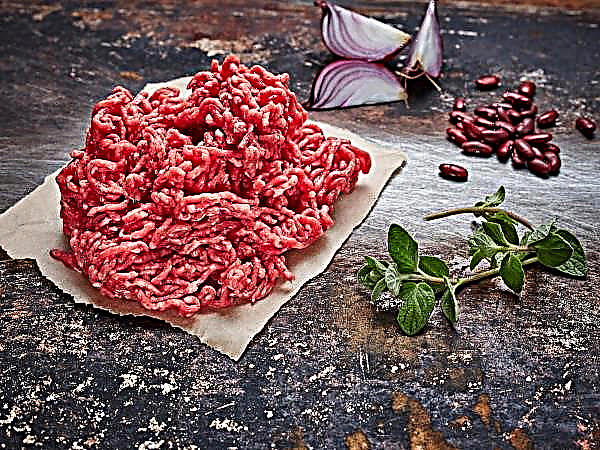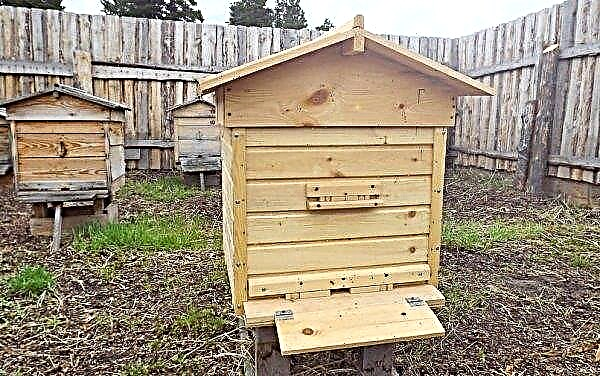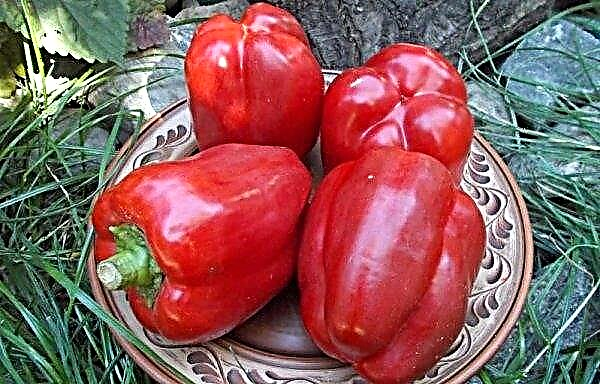Sauerkraut is a common dish when creating winter preparations, so it is not surprising that today there are a large number of recipes. Together with the classic options, it is worth using “exotic” ones for a change, which will be discussed in the article.
Selection and preparation of ingredients
The main ingredient in the preparation of such snacks is always cabbage, so the question of its choice should be given special attention. If possible, give preference only to dense, resilient and moderately shiny heads, without signs of damage by pests or disease. It is good if all of them were grown without the use of pesticides and growth stimulants, although this can only be verified with independent control of the growth process.
Did you know? According to archaeological excavations, our ancestors grew cabbage back in the Bronze and Stone Age, and its spread around the world began from Ancient Egypt.
Similar requirements are put forward to other components of this or that recipe: apples, carrots, berries should always be as fresh and clean as possible, without the slightest sign of spoilage. Of course, each fruit should be washed and, if necessary, peeled, which will necessarily be mentioned in the recipe.

Sauerkraut recipes with apples
The most popular recipe for making homemade fermentation from cabbage and apples is its classic version, using the minimum amount of ingredients. For those who appreciate the sophistication and unusualness of dishes, there are options with the use of more exotic ingredients: cranberries, lemon or even pumpkin. Of course, in each individual case there are features of creating a workpiece, which you should know about before you start work.
Classical

1 can for 3 l45 minutes
carrot
4 things. small or 2 pcs. major
salt (large)
2.5 tbsp. l without slide
Nutritional value per 100 g:
- Wash the head of cabbage, remove several top sheets from it and chop in the usual way (using a grater or knife).
- Pour the chopped cabbage into a large saucepan and tamp lightly.
- Peel, wash and grate the carrots on a coarse grater, then pour it on the cabbage.
- Wash the apples, cut into 4 parts and remove the core with seeds.
- Salt the cabbage and carrot mixture and remember the sliced vegetables so that they let the juice go.
- Transfer the vegetable mixture to a prepared, sterilized jar, filling it about half (with a large amount of vegetable, you can use barrels or buckets).
- Lay large pieces of apples (preferably slices) in a circle on top of the vegetable mixture, and sprinkle them with the remaining cabbage on top, filling the jar to the base of the neck.
- Dissolve in water ½ tbsp. salt and fill everything with the resulting liquid.
- Take a wooden spoon with a long handle and pierce it with chopped vegetables in several places (to the bottom). In the future, this procedure must be repeated every day, thereby stimulating the exit of excess gas from the can during the fermentation of the vegetable.
- Cover the filled jar with gauze and leave at room temperature for 3 days, and after this time you can transfer the workpiece to cooler conditions.
Important! Before placing the can with the workpiece for three-day storage, substitute a bowl under the bottom so that in case of juice transfusion through the neck, it does not fall on the table surface.
Video recipe
With carrots

1 can for 1 liter40 minutes
apples (sweet and juicy)
200 g
Nutritional value per 100 g:
 Wash and chop cabbage, then grate peeled carrots on a coarse grater.
Wash and chop cabbage, then grate peeled carrots on a coarse grater. Mix both ingredients in a separate container, without much kneading.
Mix both ingredients in a separate container, without much kneading. Peel and grate the apples, leaving only the middle with the seeds intact.
Peel and grate the apples, leaving only the middle with the seeds intact. Add them to the ready-made mixture and after uniform distribution throughout the volume, transfer to a sterilized liter jar. Cover the jar with a lid.
Add them to the ready-made mixture and after uniform distribution throughout the volume, transfer to a sterilized liter jar. Cover the jar with a lid. Boil 0.5 l of water and dissolve sugar, salt and citric acid in it, bringing the mixture to a boil.
Boil 0.5 l of water and dissolve sugar, salt and citric acid in it, bringing the mixture to a boil. Pour the prepared vegetable salad with boiling marinade, gently mix the top layer with a fork (air should go out) and cover it with a lid and put it in a saucepan with warm water for further sterilization (for a liter jar 15 minutes are enough after the liquid begins to boil).
Pour the prepared vegetable salad with boiling marinade, gently mix the top layer with a fork (air should go out) and cover it with a lid and put it in a saucepan with warm water for further sterilization (for a liter jar 15 minutes are enough after the liquid begins to boil). Upon completion of sterilization, carefully remove the jar from the pan and roll it with a key.
Upon completion of sterilization, carefully remove the jar from the pan and roll it with a key. Turn the blank upside down and place on a towel, covering with a blanket from above. After complete cooling, the cans are taken out to a permanent storage.
Turn the blank upside down and place on a towel, covering with a blanket from above. After complete cooling, the cans are taken out to a permanent storage.
Video recipe
With lemon, pumpkin and carrots

1 can of 3 l30 minutes / 2 days
medium-late cabbage
1,5 kg
black pepper (peas)
10-12 pcs.
Nutritional value per 100 g:
 Wash the cooked vegetables, remove the top leaves from the cabbage and chop it in medium slices.
Wash the cooked vegetables, remove the top leaves from the cabbage and chop it in medium slices. Peel the carrots and pumpkin from the skin and grate them on a coarse grater, then pouring the chopped vegetables to the chopped cabbage.
Peel the carrots and pumpkin from the skin and grate them on a coarse grater, then pouring the chopped vegetables to the chopped cabbage. Wash the lemon well and grate its zest on a fine grater, being careful not to touch the pulp (you can immediately add the zest to the rest of the ingredients of the future harvest).
Wash the lemon well and grate its zest on a fine grater, being careful not to touch the pulp (you can immediately add the zest to the rest of the ingredients of the future harvest). Cut the remaining whole flesh of the lemon into two parts in the middle and squeeze the juice from one half (into a separate container).
Cut the remaining whole flesh of the lemon into two parts in the middle and squeeze the juice from one half (into a separate container).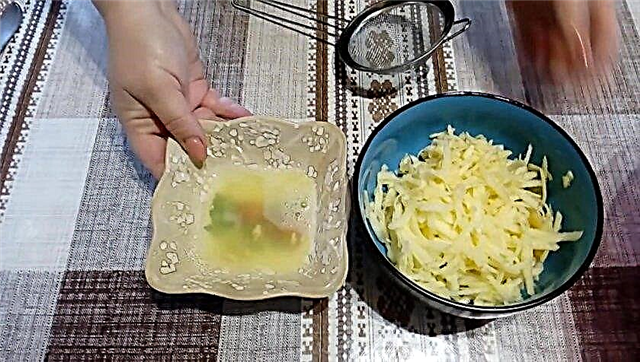 Peel and grate apples on a coarse grater, then add strained lemon juice to them and mix everything thoroughly. Unlike apple juice, lemon juice does not darken, preventing this phenomenon in the case of apple pulp.
Peel and grate apples on a coarse grater, then add strained lemon juice to them and mix everything thoroughly. Unlike apple juice, lemon juice does not darken, preventing this phenomenon in the case of apple pulp. Leave the apples for 5 minutes, then add to the rest of the products and mix well, trying to squeeze the juice slightly.
Leave the apples for 5 minutes, then add to the rest of the products and mix well, trying to squeeze the juice slightly. After mixing all the fruit and vegetable components, transfer the finished salad to a steamed jar with a volume of three liters and compact everything well, leaving at least 5 cm of free space to the edge of the jar.
After mixing all the fruit and vegetable components, transfer the finished salad to a steamed jar with a volume of three liters and compact everything well, leaving at least 5 cm of free space to the edge of the jar. Put bay leaf and add black pepper (peas).
Put bay leaf and add black pepper (peas). Pour cold boiled water into a jar, pour salt and sugar, and as soon as they dissolve well, pour the finished marinade into a jar of prepared vegetable.
Pour cold boiled water into a jar, pour salt and sugar, and as soon as they dissolve well, pour the finished marinade into a jar of prepared vegetable. Put the filled jar on a bowl, cover with folded gauze and place in a warm place for 1-2 days (the warmer the room, the faster it turns out to ferment the cabbage).
Put the filled jar on a bowl, cover with folded gauze and place in a warm place for 1-2 days (the warmer the room, the faster it turns out to ferment the cabbage). Before the fermentation process is completed, the vegetable must be pierced with a wooden stick, and in several places at once, so that excess air systematically exits.
Before the fermentation process is completed, the vegetable must be pierced with a wooden stick, and in several places at once, so that excess air systematically exits.
You can determine the readiness of the snack by the taste of the brine and the crispness of the vegetable itself. If the liquid tastes good, and it seems acidic enough, and the cabbage is already crunching well, then you can cover the container with a capron lid and move the workpiece into the refrigerator, where it will stand for the next day. Ready-made pickled stew with pumpkin, carrots and lemon can be stored for several months, though only if the appropriate temperature conditions are observed.
Video recipe
Did you know? The red variety of vegetables is not only a source of valuable components, but also an excellent food coloring. Juice of such cabbage gives other products a pleasant soft blue hue, due to which it is often used in the confectionery business.
With cranberries

Throughout the entire period of vegetable starter culture, it is necessary to clean the inverted plate daily and pierce the workpiece with a wooden stick in several places, thereby achieving the release of gas bubbles and improving the fermentation process. If you do not do this, the workpiece will be bitter, it will get an unpleasant odor. It will take another week to fully complete the fermentation process, but after 3-4 days you can transfer the contents to a jar and send them for storage in a refrigerator or other cool place.
Video recipe
With cranberries Video recipe: With cranberries [/ recipeInstructions]
With cranberries and mountain ash

140 minutes / 3 days
White cabbage
3 kg
apples (winter varieties)
2 pcs.
Nutritional value per 100 g:
- Wash and clean the head of cabbage, removing the top leaves from it.
- Chop the vegetable with a knife, after dividing the head into 4 parts.
- Salt the cabbage and mash it thoroughly until juice appears (it should become softer to the touch).
- On a coarse grater, rub the washed and peeled carrots, then carefully mix it with the previous ingredient, trying to achieve an even distribution of each component in the total mass.
- Cut the washed apples into slices and set them aside for a while.
- Take a suitable volume for the starter culture (at home it is better to ferment the cabbage in an enamel pan) and put the previously removed cabbage leaves on the bottom.
- With the next layer, place the salted cabbage-carrot mixture inside, ramming it well.
- Lay out half the apples, pour cranberries and mountain ash scalded with boiling water.
- Again, pour a layer of cabbage with carrots and repeat the steps again, filling the container to the top with the workpiece.
- At the end of the procedure, pour rammed cabbage with infusion of oak bark and, waiting for it to be completely absorbed, install oppression (you can use a three-liter jar of water). The cabbage fermentation period is 2-3 days in a warm place.
After the specified time, you can put the delicious cabbage in banks and send it to a permanent storage place.Important! It is advisable to stick a few oak sticks around the jar installed in the pan, which will later be used for daily piercing of the cabbage mixture and will improve the fermentation process.
Video recipe
With cauliflower and honey

145-55 minutes
fresh bell pepper
1 PC.
Nutritional value per 100 g:
- Wash the prepared vegetables, remove the top leaves from the white cabbage, grate the head of cabbage on a medium grater, then carefully divide the inflorescences of the colored variety of the vegetable, grate the carrots. Cut the apples into large slices, cutting one fruit into 4-6 parts.
- Salt the cabbage and mash it well, until the individual pieces are softened.
- Put the removed upper leaves on the bottom of the prepared enameled pan, and then lay a 5-centimeter layer of already salted cabbage, pre-mixed with grated carrots.
- Spread the upper cabbage leaves again and pour on them the separated cauliflower inflorescences, another 3-5 cm thick.
- Once again, fill in a layer of chopped white cabbage mixed with carrots, then tighten everything well.
- Put apples and sliced bell pepper on top, again filling everything with cabbage-carrot mixture and ramming it as much as possible.
- Pour the prepared homemade honey, trying to evenly distribute it on the surface of the workpiece (due to this component, the ready-made cabbage will not only crackle well, but also turn out to be deliciously sweet).
It takes at least 3-4 days to fully “ripen” the cabbage, during which it is necessary to remove the load daily and pierce the workpiece with a wooden stick, reaching it until the day of the vessel. With the right procedure, the prepared cabbage will certainly be sweet and tasty, without the slightest sign of bitterness in the taste.
Video recipe
Features of storage of blanks
Sauerkraut is not stored as long as canned harvesting options, but subject to certain rules, there is still a chance to provide yourself and loved ones with a tasty and healthy vegetable for the whole winter:
- The air temperature at the place of storage of the vitamin preform should be within + 2 ... + 7 ° C.
- When choosing a store, it is worth avoiding rooms that are well lit by sunlight (it is better if the cabbage is in partial shade).
- If possible, prepare the workpiece using small oak barrels, but enameled utensils are also suitable in apartment conditions.
- To increase the shelf life of the finished product, it is worth using cranberry berries, and when using mountain ash, it is advisable to scald it with boiling water in advance.
- Make sure that in a bowl with cabbage there is always a sufficient amount of brine, preventing the drying of chopped vegetables. Without it, the product cannot be called good fermentation.
- If mold appears on the surface of the workpiece, it must be carefully removed and then sprinkled with a small amount of mustard powder, if necessary repeating this procedure in the future.
 Sauerkraut is very tasty in its “fresh” form, but if you fear for its safety, it is worth considering the option of freezing. Stored in the refrigerator, the product will not lose its taste and vitamin properties, and you can use the preparation for a whole year
Sauerkraut is very tasty in its “fresh” form, but if you fear for its safety, it is worth considering the option of freezing. Stored in the refrigerator, the product will not lose its taste and vitamin properties, and you can use the preparation for a whole year
By choosing the appropriate recipe for preparing the described snacks and observing the rules for its further storage, each housewife will be able to get a good source of vitamins for the whole family, which is so lacking in the cold season.

 Wash and chop cabbage, then grate peeled carrots on a coarse grater.
Wash and chop cabbage, then grate peeled carrots on a coarse grater. Mix both ingredients in a separate container, without much kneading.
Mix both ingredients in a separate container, without much kneading. Peel and grate the apples, leaving only the middle with the seeds intact.
Peel and grate the apples, leaving only the middle with the seeds intact. Add them to the ready-made mixture and after uniform distribution throughout the volume, transfer to a sterilized liter jar. Cover the jar with a lid.
Add them to the ready-made mixture and after uniform distribution throughout the volume, transfer to a sterilized liter jar. Cover the jar with a lid. Boil 0.5 l of water and dissolve sugar, salt and citric acid in it, bringing the mixture to a boil.
Boil 0.5 l of water and dissolve sugar, salt and citric acid in it, bringing the mixture to a boil. Pour the prepared vegetable salad with boiling marinade, gently mix the top layer with a fork (air should go out) and cover it with a lid and put it in a saucepan with warm water for further sterilization (for a liter jar 15 minutes are enough after the liquid begins to boil).
Pour the prepared vegetable salad with boiling marinade, gently mix the top layer with a fork (air should go out) and cover it with a lid and put it in a saucepan with warm water for further sterilization (for a liter jar 15 minutes are enough after the liquid begins to boil). Upon completion of sterilization, carefully remove the jar from the pan and roll it with a key.
Upon completion of sterilization, carefully remove the jar from the pan and roll it with a key. Turn the blank upside down and place on a towel, covering with a blanket from above. After complete cooling, the cans are taken out to a permanent storage.
Turn the blank upside down and place on a towel, covering with a blanket from above. After complete cooling, the cans are taken out to a permanent storage. Wash the cooked vegetables, remove the top leaves from the cabbage and chop it in medium slices.
Wash the cooked vegetables, remove the top leaves from the cabbage and chop it in medium slices. Peel the carrots and pumpkin from the skin and grate them on a coarse grater, then pouring the chopped vegetables to the chopped cabbage.
Peel the carrots and pumpkin from the skin and grate them on a coarse grater, then pouring the chopped vegetables to the chopped cabbage. Wash the lemon well and grate its zest on a fine grater, being careful not to touch the pulp (you can immediately add the zest to the rest of the ingredients of the future harvest).
Wash the lemon well and grate its zest on a fine grater, being careful not to touch the pulp (you can immediately add the zest to the rest of the ingredients of the future harvest). Cut the remaining whole flesh of the lemon into two parts in the middle and squeeze the juice from one half (into a separate container).
Cut the remaining whole flesh of the lemon into two parts in the middle and squeeze the juice from one half (into a separate container). Peel and grate apples on a coarse grater, then add strained lemon juice to them and mix everything thoroughly. Unlike apple juice, lemon juice does not darken, preventing this phenomenon in the case of apple pulp.
Peel and grate apples on a coarse grater, then add strained lemon juice to them and mix everything thoroughly. Unlike apple juice, lemon juice does not darken, preventing this phenomenon in the case of apple pulp. Leave the apples for 5 minutes, then add to the rest of the products and mix well, trying to squeeze the juice slightly.
Leave the apples for 5 minutes, then add to the rest of the products and mix well, trying to squeeze the juice slightly. After mixing all the fruit and vegetable components, transfer the finished salad to a steamed jar with a volume of three liters and compact everything well, leaving at least 5 cm of free space to the edge of the jar.
After mixing all the fruit and vegetable components, transfer the finished salad to a steamed jar with a volume of three liters and compact everything well, leaving at least 5 cm of free space to the edge of the jar. Put bay leaf and add black pepper (peas).
Put bay leaf and add black pepper (peas). Pour cold boiled water into a jar, pour salt and sugar, and as soon as they dissolve well, pour the finished marinade into a jar of prepared vegetable.
Pour cold boiled water into a jar, pour salt and sugar, and as soon as they dissolve well, pour the finished marinade into a jar of prepared vegetable. Put the filled jar on a bowl, cover with folded gauze and place in a warm place for 1-2 days (the warmer the room, the faster it turns out to ferment the cabbage).
Put the filled jar on a bowl, cover with folded gauze and place in a warm place for 1-2 days (the warmer the room, the faster it turns out to ferment the cabbage). Before the fermentation process is completed, the vegetable must be pierced with a wooden stick, and in several places at once, so that excess air systematically exits.
Before the fermentation process is completed, the vegetable must be pierced with a wooden stick, and in several places at once, so that excess air systematically exits.